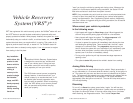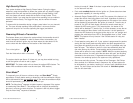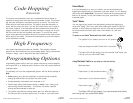
G438.696
© 1994, 1995 Directed Electronics, Inc. 8 95G438.PM5
Nuisance Prevention Circuitry
TM
Your system has DEI's Nuisance Prevention Circuitry™ (NPC™). It prevents
annoying repetitive trigger sequences due to faulty door pin switches or
environmental conditions such as thunder, jackhammers, airport noise, etc.
Here's how it works:
Let's say the alarm triggers
three times
. Each time, the same sensor or switch
is triggering the alarm. The three triggers are within 60 minutes of each other.
NPC™ will interpret this pattern of triggers as false alarms. After the third
trigger, NPC™ ignores, or bypasses, that sensor or switch (along with any
other sensors or switches sharing the same zone).
If the bypassed sensor tries to trigger the system while it is being bypassed,
the 60-minute bypass period will start over. This ensures that a sensor that
continuously triggers will remain bypassed.
Doors are covered by NPC™ differently: If the alarm is triggered by an open
door for three full cycles (one and one half minutes), the doors will be by-
passed until the trigger ceases.
NOTE: Arming and disarming the system does not reset this function! The only
ways to reset a bypassed zone are for it to not trigger for 60 minutes, or to turn
on the ignition. If testing your system, it is important to remember that the
NPC™ programming can cause zones to be bypassed and seem to stop
working. If five chirps are heard when disarming, NPC™ has been engaged. If
you wish to clear the NPC™ memory, turn the ignition on.
Diagnostics
The microprocessor at the heart of your system is constantly monitoring all of the
switches and sensors connected to it. It detects any faulty switches and sensors
and prevents them from disabling the entire system. The microprocessor will also
record and report any triggers that occurred during your absence.
Arming Diagnostics
If the system is armed with an input active (door open, sensor triggering, etc.)
the unit will chirp once when arming and then one more time a few seconds
later. This is called Bypass Notification.
Note: Bypass notification will not occur when using Silent Mode™ or if chirps
have been programmed OFF.
G438.696
© 1994, 1995 Directed Electronics, Inc. 9 95G438.PM5
The system will ignore the input that was active when it was armed until it
goes away. Three seconds later it will monitor that input normally. For ex-
ample, if your car has interior light exit delay, and you arm the system before
the interior light goes out, you may get Bypass Notification. Three seconds
after the light goes out, however, the doors are monitored normally.
Disarming Diagnostics
Extra disarm chirps are the Tamper Alert. If
four
chirps are heard when
disarming, the system was triggered in your absence. If
five
chirps are heard,
a zone was triggered so many times that Nuisance Prevention Circuitry™ has
bypassed that zone. In either case, the Status LED will indicate which zone
was involved (see
Table of Zones
section). The system will retain this informa-
tion in its memory, and chirp four or five times each time it is disarmed, until
the next time the ignition key is turned on.
If the Warn Away
®
response is triggered, the LED will not report it.
Table of Zones
The zone number is the number of LED flashes used by the system to identify
that input. The standard input assignments are listed below, along with spaces
to write in any optional sensors or switches you have had installed.
ZONE (# of LED
FLASHES)
DESCRIPTION
DEALER INSTALLED
OPTIONS
1 Instant trigger
2
A heavier impact trigger
of the shock sensor
3 Door switch circuit
4
Instant trigger of
optional sensors
5 Ignition










